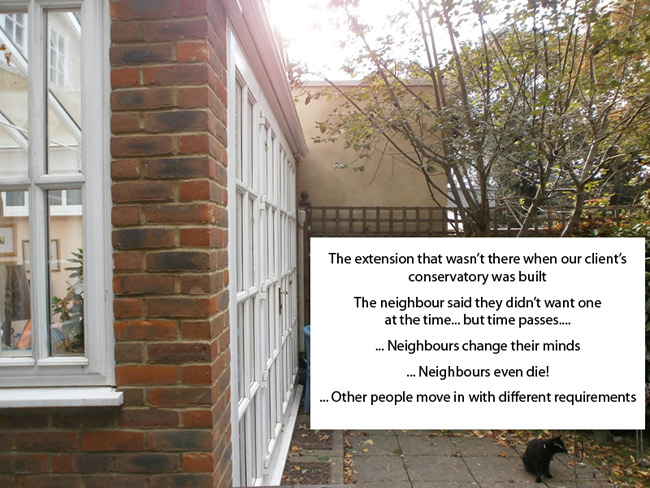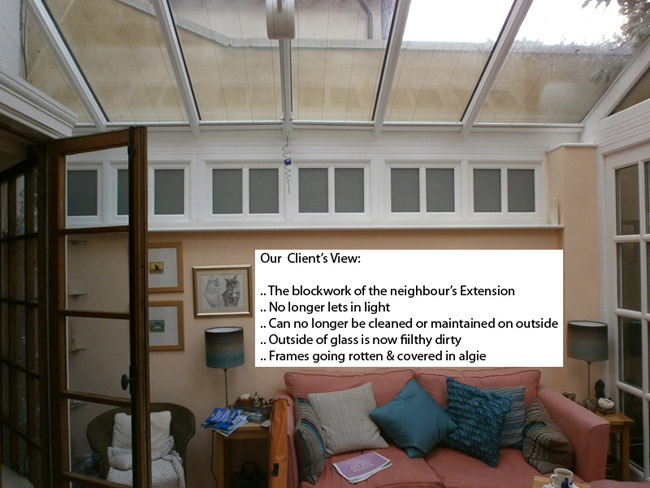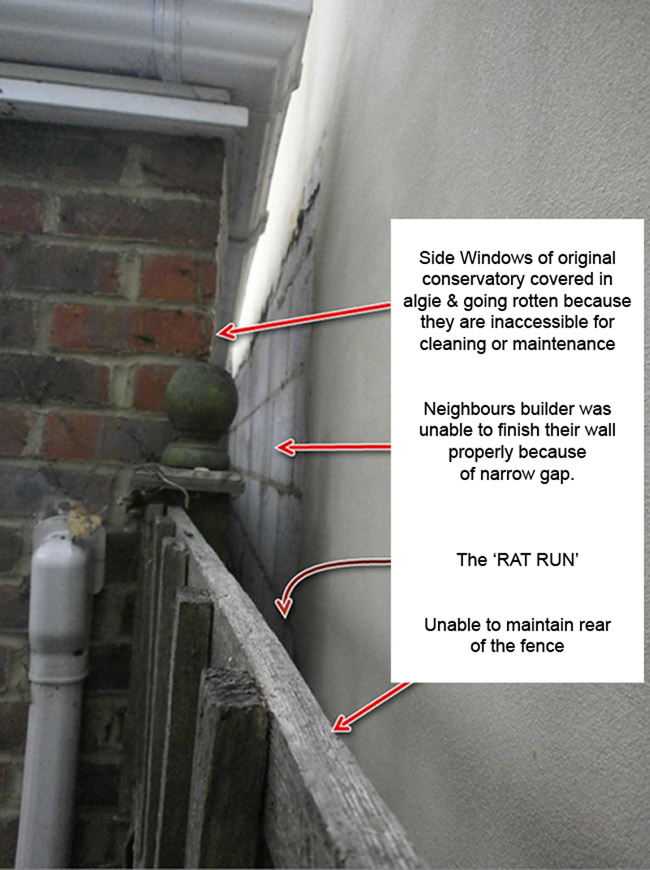Glazing next to a Boundary is NOT a good move
Why is glazing next to a Boundary NOT a good move?
Almost every week I get asked to include glazing next to a boundary, or on the boundary, which I always refuse. In 35 years, I’ve never done it and I’ll walk away from any job where my client insists it’s what they want! Perhaps, I should explain why?
There are several reasons and I’ll deal with them one by one, but I’ll be leading up to the last one, which is really the most important.
-
Sound Privacy:
It really isn’t a good idea having glazing close to or adjacent to the boundary with a neighbour, not only from a visual point of view, but also sound. A glass sealed unit is not as good a sound insulator as an insulated cavity wall. Not only that, I have come across many conservatories where there is an opening window close to the boundary. I assure you, your neighbour will be able to overhear every word of your conversations. I hope you are not talking about them!
-
Visual Privacy:
Do you really want your neighbours looking into your conservatory, or do you want the unnecessary expense of blinds?… If so, what use is the glazing? I am often told my client wants to get the light from that direction, but they’ve now got a roof full of light and when compared to their sitting room, they’ve as much light as they require without the need for it from the boundary wall. Don’t believe patterned or obscure glass will do the trick, you can still be seen moving around through anything other than expensive ‘privacy glass’.
-
Visibility from the conservatory:
Do you really want to be looking at the boundary wall, fence or hedge?… Close off an unattractive view with a full height brick wall.
-
Maintenance:
Unless you leave a gap of at least 300mm between the boundary wall, fence or hedge means you will be unable to clean the glass or maintain the frames. Even with so-called maintenance free pvc or aluminium, the glass still needs to be cleaned, gutters need to be cleared and dew on the frames will mean that spores will adhere to the surface and eventually the inaccessible frames will grow green mould.
-
Leaving a gap reduces space:
If you leave a gap of 300mm, sufficient to get around the edge of the conservatory to clean the glass, you are reducing what could be usable interior space by the same amount. Probably for a minimal extra cost.
-
The Rat-run:
I regularly see a situation where a small gap of 100-150mm has been left between the wall, fence or hedge. This is a perfect home for the type of little creatures you would prefer not to have as a neighbour.
-
The neighbour decides they want a conservatory or extension some time in the future:
… This is the big one! I am always told the neighbours don’t plan to have one and they have no objection to the new glazing adjacent to the boundary. Wake up! Have you never heard of someone changing their mind, moving, or dying and new people moving in with different plans! They then build their new extension, orangery or conservatory right up to the boundary with a nice new brick wall and many of the above situations will then apply. After all, they have no reason to restrict their plans just because you don’t like it. Remember, if they have permitted development rights intact, they can build a conservatory, orangery or single storey extension up to 3m in projection and 4m in height, without involving planning. Instead of sunshine streaming through your side windows or gable, you will then see the blockwork on the side of their wall, a few inches away… for the time being that is, until your windows become so dirty and mouldy you can’t see anything!
At least 4-5 times a year, I arrive at a client’s site where they want a conservatory and find it really difficult to find a satisfactory solution, because of a thoughtless design on the neighbour’s boundary. I don’t blame the neighbour, I blame the sales person, or so-called designer, who most likely hasn’t discussed the potential problems with their client, being all too keen to ‘sign them up’, no matter their requirements. In similar situations, I’ve had sales people just saying “That’s what they want”. However, it’s our responsibility to provide good advice and provide a solution that is “Fit for Purpose!”
I’m often told “No-one else has said it is a problem”. My answer, “I can’t be responsible for other people’s irresponsible advice… or their lack of good advice!” In 35 years, I’ve NEVER glazed adjacent to a boundary!





